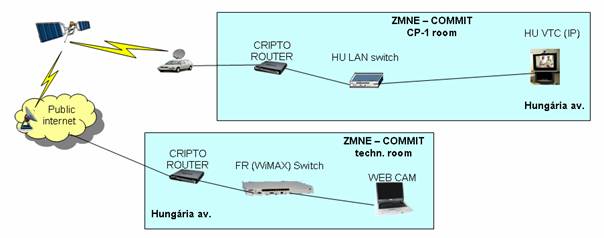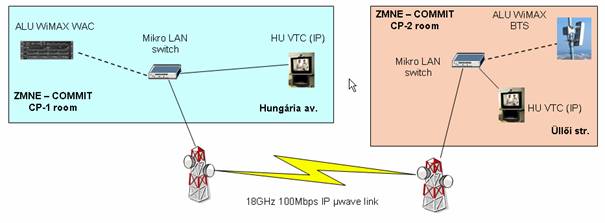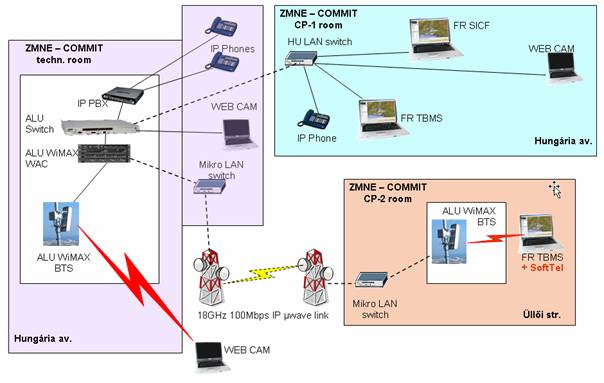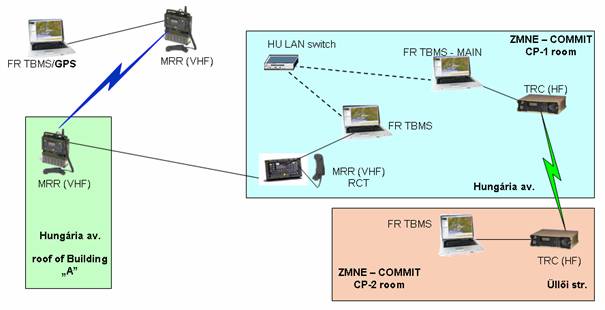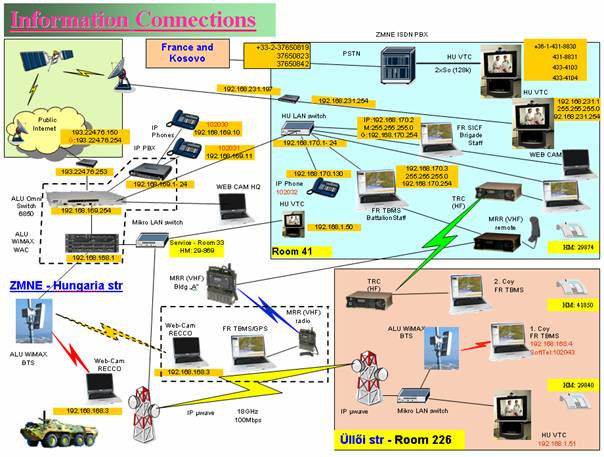Abstract/Absztrakt In my article, I wanted to present the technological background of the new technical solution tested at the COMMIT-2007 international infocommunications exercise. The exercise was presented with the participation of French, Romanian and Hungarian participants. The systems were broken up to more layers. I wanted to demonstrate the path to the development of the complex system through the different layers. The presentation of the realization provides a good base for the testing of a further, greater realization. My article also connects to the theme of my Ph. D. dissertation, where I analyze the potential of military employment of WiMAX systems. Cikkemben a COMMIT-2007 nemzetközi infommunikácós gyakorlaton kipróbált új technikai megoldás műszaki hátterét kívántam bemutatni. A gyakorlat francia, román és magyar résztvevőkkel zajlott. A hálózat igen heterogén volt, de a gerinchálózati megoldások IP alapúak voltak. A rendszerek több rétegre voltak bonthatók. A különböző rétegek bemutatásán keresztül kívántam az összetett rendszer kialakításához vezető utat szemléltetni. A megvalósítás bemutatása jó alapot teremthet a rendszer további, nagyobb méretű megvalósításának a teszteléséhez. Cikkem kapcsolódik PhD értekezésem témájához is, ahol a WiMAX rendszerek katonai alkalmazásának lehetőségeivel foglalkozom. Keywords/Kulcsszavak: WiMAX, COMMIT-2007, TBMS, Tactical Battle Management System, infocommunications, network, backbone - WiMAX, COMMIT-2007, TBMS, harcászat, harctéri menedzsment rendszer, infokommunikáció, hálózat, gerinchálózat
INTRODUCTION On the COMMIT-2007 international infocommunications exercise, we tested a new type of network solutions. The exercise was presented with the participation of French, Romanian and Hungarian participants. While planning the network, we tried to integrate the utmost technical solutions. The systems were working through IP-based backbone networks. Through the access points, we had the choice to use ISDN- and IP-based tools at the same time. The integration of the systems was based on the newly developed WiMAX base. The WiMAX also assured the network management functions. We were trying to use civil and military solutions at the same time (civil satellite service, microwave backbone network, videoconference terminals and military radios and computers). The primal objective of the exercise was to test the new high-speed data transmission's technical solution in multi-language environment. During the execution, we had no compatibility issues. The realized system assured the reliable contact through all channels. The goal of my article is to present the technical buildup of the realized subsystems and the representation of the system integration. The presentation of the realization provides a good base for the testing of a further, greater realization. My article also connects to the theme of my Ph. D. dissertation, where I analyze the potential of military employment of WiMAX systems. TECHNICAL REALIZATION The COMMIT-2007 system exercise was built on a quite heterogenic technological background. All tools were able to connect to the flexible IP-based core- and backbone network system without compatibility issues. While installing the system, the structure was to be changed because of user demands. We tried to present the utmost wide range of technical options. The imitated military tasks were built on the technical presentation. The task was limited in time, thus not all technological opportunities were presented. While establishing the system, we had to consider that the frequency band of the presented WiMAX system required authorization. The technological background was built up on five stand-alone working and also co-operative systems:
The system's technical buildup is shown on the following illustrations.
The second figure shows the IP-based satellite connection, which has been strung at one side on the WiMAX system. This way it was solvable to reach the leading point with another protected, built on a VPN-based structure, encrypted channel for any system element with the correct rights. Its main purpose was the service of the videoconference terminals. If needed, it also could have been used for data transmission. The transmission speed and the quality channel made the effective execution possible. The third figure shows the microwave IP link between campuses. This backbone network provided the IP-based videoconference and the connection between the two base stations of the WiMAX system (ALU WiMAX BTS). Only a small segment of the transmission capacity was used, it could have been able to connect a much more numerous system. The distribution of the capacity became an IP-address distributing-only question. In the current task it was not used, but the microwave tool's indoors ending is directly connectable to an E1 ISDN line (for example, co-operating the department's digital switching centers between campuses). The fourth figure shows the connection structure of the installed WiMAX system. The presentation set brought to the exercise (because of the lack of antennas and the proper interfaces) could not provide the area coverage and the backbone network connection at the same time. After technical reconciliations, the area covering solution was installed. The area coverage was realized by radiating sectors, which provided the connection with IP-based tools to the leading system (SICF and MAESTRO) and option of fast forwarding of real-time information (Picture data /WEB CAM/, GPS data of moving objects, usage IP service telephones, etc.). The transmission between campuses was realizes with "expansion" backbone shown on the Figure No. 3. In reality, a stand-alone backbone also could have been built (by installing new antennas) for a distance of a few kilometers (at the current power). The mobile informatics tools could have connected to the network through WiMAX-PCMCIA cards and/or UTP cable, with a switch. The network was controlled by the WiMAX network management center (ALU WiMAX WAC). While installing it, the rights, security levels and network accesses were set
Figure No. 5. shows the co-operative system built of military HF and VHF radios, expanded with informatics tools. The radio network was to fulfill the transceiver role; its main purpose was the data transmission. The base elements of the leading system were the TBMS computers. Their co-operation on HF and VHF band was provided with a cable-based connection through switch at the main leading point, where the option of connecting to the other elements of the network was given (for example, WiMAX, etc.). The sixth figure shows the connection of the informatics system. It is clear that it is hardly separated from the other elements of the system. The main reason is that a mostly IP-based, network-based system was realized. In the IP structure the main limit is the co-operative and service ability of the used software. During the operation the compatibility level is provided by all system elements. During the exercise, we have used numerous common (civil) solutions. The bandwidth provided was proved to be enough for all tools and transmitting solutions. Most of the practical problems were produced by the temporarily lack of QoS abilities (for example, the video connection of Windows Netmeeting provided weak image quality even with high bandwidth and high quality web camera. This was audible on the sometimes erratic speech). SUMMARY The hardware build out of the full realization was executable quite fast. The rights, IP distribution and solving of other network management questions took much more time. The systems co-operated reliable. The complex network (seventh figure) served the demands of the leading and serving channels. The problems arose from the occasional lack of software support of the QoS. The occurring problems have not caused neither technological nor leading hang. The multiple redundancies provided the option of the fast oppression between channels. In the future, we must be prepared to execute these kinds of tasks in not only simulated military tasks. In my opinion the movement towards IP is already present in military networks. The WiMAX will be able to take either the backbone network or the area-covering functions in the environment of the leading points. Its military application must be considered in the future.
REFERENCES [2] Nemzeti Hírközlés hatóság: Szélessávú Adatátvitel Rádiós Hozzáférési Eszközökkel (RLAN, WiFi, WMAN, WiMAX,...), 2. kiadás, Budapest, 2006. október 1. [3] Dr. Grad János: Új WiMAX alkalmazások, Nemzeti Hírközlés hatóság, Budapest, 2006. [4] International Telecommunication Union: ITU defines the future of mobile communications; ITU Radiocommunication Assembly approves new developments for its 3G standards; Genova, 2007. október 19. [5] WiMAX forum: WiMAX's technology for LOS and NLOS environments [6] White Paper - Accelerating WiMAX System Design with FPGAs
Notes |
© ZMNE BJKMK 2007.


